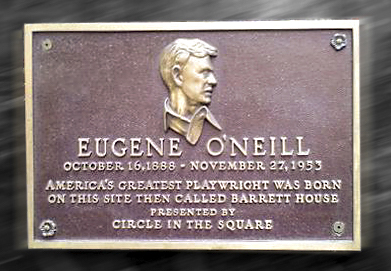Every New York artist needs to surround themselves with a creative community. The dreams of this community are always big. The goal is usually to go from small readings to lavish productions that change the face of an industry. It’s rare, but it does happen. In fact, it happened to today’s playwright: Eugene O’Neill. Though he had some turmoil in his life, he took a small band of ragtag theater enthusiasts and built an institution that still stands to this day. From there he went on to become a legend, winning prestigious awards and even getting a Broadway theater named for him. But let’s not get ahead of ourselves. Let’s start at the beginning.
Eugene O’Neill was born in 1888 in Longacre Square, NYC. His theater education started early. His birthplace was the Barrett House, a hotel in Times Square near the Morosco Theater, the future site of O’Neill’s Broadway debut. While neither of those buildings are around anymore, they played a major role in O’Neill’s life, almost as if his theater legacy were preordained. Speaking of, his father was James O’Neill, a famous touring actor of the era. Touring is the operative word, since O’Neill spent most of his early life bouncing around them until he was sent off to boarding school.
He’d only see his family again during the summers at their only permanent retreat, a house in New London Connecticut. Essentially, O’Neill never really had an “in place” childhood. He was always moving. Once he got to Princeton, for example, he left after ten months, though not by choice as he was sent to a sanatorium to heal from a bout of Tuberculosis. It was here he began writing plays.
In 1916, O’Neill moved to Provincetown, Massachusetts and joined a group of young artists putting together experimental theater shows. They were called The Provincetown Players, and they produced O’Neill’s first work since the sanatorium, Bound East for Cardiff. The show, a story about a dying sailor coming to terms with his mortality, was a commercial success for the small theater, and the group decided to move to Greenwich Village where many of the players were from. It would be the first time Eugene was back in New York City since his university days.
At 139 Macdougal Street, the Provincetown Players converted an old apartment building into a theater. Apparently, the theater was awful. The stage was small and the benches for the audience were said to be painfully uncomfortable. Lucky for them, they wouldn’t be in that venue for very long. Just two years later they moved to a better location at 133 Macdougal Street, which is the location that still houses the theater to this day. The venue quickly became famous, even amongst New York’s most staunch theater critics, who would visit to catch a glimpse at the new shows that would surely be household names.
It wasn’t long before O’Neill was making his Broadway debut. In 1920, Beyond the Horizon, was produced at the Morosco Theater, a popular venue that was, sadly, destroyed in the 1980’s. Though the theater might be gone, the legacy remains. The legacy of a young boy with a strained relationship to his family, who nearly died, and found a group of people to share and grow with. All of these instances were reflected in Beyond the Horizon. The story is that of two brothers, who literally drift apart as one goes out to sea as the other lives the life that was supposed to belong to his brother. O’Neill won his first Pulitzer Prize for it.
For the next two decades, O’Neill would go on to write many plays and win three more Pulitzer Prizes. His plays always invoked his personal experiences, sometimes to extreme degrees. For example, his play, Long Day’s Journey Into Night, was an autobiographical account of his life with his mother, father, and brother before he went to the sanatorium. All four struggled with addiction, and all four struggled with loving each other, even when they didn’t quite know how. O’Neill never even meant for the show to be published in his lifetime. It was only to be produced after his death. He got his wish in 1953.
Still his major shows, Long Day’s Journey Into Night and Iceman Cometh, didn’t come until after he had won his Nobel Prize in Literature in 1936. He’s the only American Playwright to have such an honor. He had a ten year pause after that, moving out of New York and bouncing around his various homes and hotels where he felt he could finally relax. Yet he never stopped working, and came back to New York to produce The Iceman Cometh in 1946. O’Neill died in 1953 in Boston, and Long Day’s Journey Into Night opened at the Helen Hayes Theater four years later. It won the Tony for best play.
Though he died, Eugene O’Neill’s legacy isn’t quite done. His name shines on Broadway on 49th street. The theater, formerly the Forrest Theater and the Coronet Theater, was named after O’Neill in 1959, six years after his death. The O’Neill, along with 21 other theaters, was given landmark status in 1987, forever cementing the playwright’s name in the theater district, and in the heart of New York. Though gone, he has never been forgotten. His works are still taught in classrooms today as some of the best American theater has to offer.
Some say that Eugene O’Neill is the greatest playwright of his generation. His Nobel Prize would certainly support that theory. However, before his accolades and triumphs, there was just a young artist in New York City fighting for his dreams. His story, the early part anyway, mirrors many of the artists that have lived, and will live, in the city. He banded together with a group of likeminded artists, found a venue, and put on shows hoping people would see them, and be affected by them. His popularity exploded, but he was always the same kid born in a New York City Hotel. He was always the same starving, Greenwich Village artist. It goes to show that anyone can rise to greatness given the chance. Maybe one day, another American playwright will win a Nobel Prize, and have their name in lights on Broadway after creating a smaller theater that’s lasted more than a century.
Russell is a writer and comic based in New York City. His plays have been featured at Penn State’s Cultural Conversation’s Festival, The NYC Thespis Festival, and Imaginarium’s Inaugural Theater Festival. Follow him on TikTok and Instagram @pooleparty528



